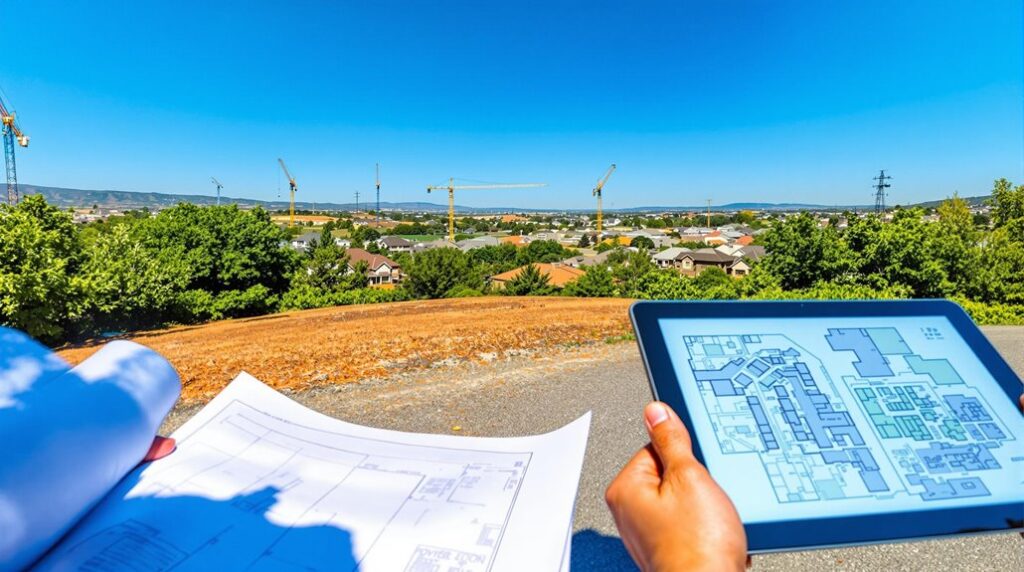I’ve learned that buying property for development without proper assessment is like gambling with your financial future. The difference between a profitable project and a costly mistake often comes down to understanding five critical factors before you sign any papers. Most investors skip these essential steps and end up facing unexpected restrictions, infrastructure costs, or zoning issues that kill their returns. Let me walk you through the systematic approach I use to evaluate every property’s true development potential.
Key Takeaways
- Verify zoning laws and permitted uses through local planning portals to confirm development rights exist.
- Research nearby amenities, transportation access, and planned infrastructure projects that enhance property value and demand.
- Confirm utility availability at property boundaries and assess infrastructure condition to avoid costly extensions.
- Calculate financial returns using development margin approach, including 10-15% contingency reserves for unexpected costs.
- Conduct soil tests and topography assessments to identify physical constraints that may limit buildable area.
Understanding Zoning Laws and Development Rights
Where exactly do you start when evaluating a property’s development potential? I always begin by examining the existing zoning plan—raw land without proper zoning lacks development rights entirely. You’ll need to understand what the zoning laws permit: building types, heights, densities, and allowable uses.
I recommend checking local council planning portals for free government reports that verify permitted uses. Don’t overlook overlay zones like heritage or flood-prone areas—they’ll impose additional restrictions beyond base zoning. Pay attention to minimum lot sizes, setback requirements, and maximum building coverage, as these define your development scope.
Here’s what I’ve learned: future zoning changes can dramatically impact property value, so analyze potential amendments before you buy. When conducting your analysis, remember that comparable investments typically carry more weight with financial institutions during the assessment process.
Evaluating Location Benefits and Growth Potential
Once you’ve confirmed the zoning permits your intended development, location analysis becomes your next priority. I’ll walk you through the essential factors that determine whether you’re investing in tomorrow’s growth hub.
Start by mapping nearby amenities within a one-mile radius. Schools, hospitals, and shopping centers directly boost property values. Check public transit accessibility—residents increasingly prefer car-free lifestyles.
Next, research planned infrastructure projects. Highway expansions, new transit lines, and upcoming commercial developments signal rising demand. I recommend contacting local planning departments for five-year development blueprints.
Analyze recent comparable sales and rental rates in your target area. Rising prices indicate strong market momentum. Compare nearby development sites to understand price discrepancies and identify undervalued opportunities with development potential.
Finally, examine demographic trends through census data—population growth and increasing income levels predict sustainable demand for your future development.
Assessing Infrastructure Readiness and Utility Access
How thoroughly you assess infrastructure readiness can make or break your development’s financial viability. I’ll guide you through evaluating what’s already there versus what you’ll need to build.
Start by confirming utility availability at your property boundaries. Check water, sewer, electricity, gas, and telecommunications access. Don’t assume they’re adequate—verify capacity against your development’s projected demand. Additionally, be aware that if your property is located in a Conservation Area, certain restrictions may apply to your renovation plans.
Next, assess existing infrastructure condition. Examine road capacity, drainage systems, and electrical substations serving your area. Age and current load matter greatly here.
Research local regulatory requirements early. Zoning laws dictate infrastructure standards, and permits take time. Some developments trigger environmental impact studies. Early identification of infrastructure deficiencies can reduce cost overruns by preventing major surprises during development.
Finally, calculate enhancement costs if existing infrastructure falls short. Get quotes for extensions, upgrades, and connections. These expenses directly impact your project’s profitability and timeline.
Calculating Financial Returns and Project Viability
Three core financial models will determine whether your development project succeeds or fails financially. I’ll walk you through each one so you can make confident decisions.
Start with the development margin approach—divide your projected net profit by total development costs. This gives you a quick viability snapshot. Next, run a discounted cash flow analysis to account for money’s time value across your project timeline. Finally, conduct sensitivity analysis to test how construction cost increases or interest rate changes affect your returns. Understanding affordable property markets is crucial to making informed decisions.
Focus on these key metrics: ROI measures profit against capital invested, while IRR shows your annualized return percentage. Calculate your payback period to understand cash flow timing. Development models must also incorporate debt drawdowns that align with construction phases and cash flow requirements throughout the project lifecycle.
Always include 10-15% contingency reserves and stress-test different scenarios. You’re building financial resilience, not just properties.
Identifying Physical Constraints and Site Limitations

Your financial projections mean nothing if your site can’t support actual construction. I’ll walk you through the physical constraints that can make or break your development dreams.
Start with topography assessments. Steep slopes greatly increase construction costs and may require specialized foundation work. Order soil stability tests early—they’ll reveal whether you’re building on solid ground or potential sinkholes. Additionally, be mindful of potential damp issues that could arise if the site has poor drainage.
Check environmental restrictions next. Wetlands, protected habitats, and contaminated soil can halt projects entirely. I always verify vegetation removal permits before assuming I can clear land.
Measure your buildable area carefully. Irregular lot shapes, setback requirements, and easements reduce usable space considerably. Finally, confirm utility access. Extending water, sewer, or electrical connections costs thousands and delays timelines. Always evaluate the local infrastructure that connects to your site since inadequate roads or utilities can significantly impact both development costs and future property desirability.
These physical realities determine what’s actually possible on your site.
Conclusion
I’ve walked you through the essential steps to assess development potential: checking zoning laws, evaluating location benefits, confirming infrastructure access, calculating financial returns, and identifying site constraints. Don’t skip any of these steps—they’re your safeguards against costly mistakes. Use this systematic approach as your checklist before making any property investment. Remember, thorough due diligence now saves you from expensive surprises later. Your development success depends on getting these fundamentals right from the start.
References
- https://propertyanalytics.com.au/how-to-assess-a-propertys-development-potential/
- https://www.studocu.com/row/messages/question/3965592/property-appraisal-i-what-research-do-you-need-to-conduct-to-obtain-the-information-you-need
- https://www.altusgroup.com/featured-insights/property-development-feasibility/part-1-study-fundamentals/
- https://www.aupress.ca/app/uploads/OER-202302_Chamberlain_Dubberlboer_2023-Read-Think-Write.pdf
- https://www.buysellvacantland.com/blog/assessing-the-development-potential-of-land/
- https://www.nordicsrealestate.com/the-value-of-development-rights-is-volatile
- https://blog.harbingerland.com/land-valuation-for-development-understanding-its-basics-and-importance/
- https://communitylands.com/communitychronicle/land-buying-tips-you-need-to-know-before-buying-your-next-land
- https://www.diva-portal.org/smash/get/diva2:458424/FULLTEXT01.pdf
- https://belonghome.com/blog/location-real-estate-investment

